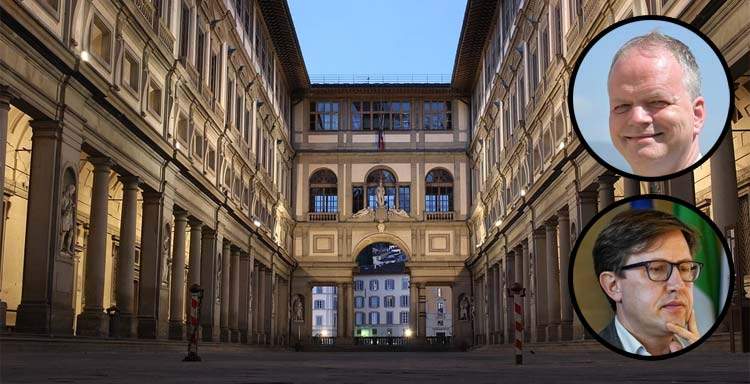More sparks between the mayor of Florence, Dario Nardella, and the director of the Uffizi, Eike Schmidt. That the two were at loggerheads had long been understood: the latest skirmishes were at Christmas, when Schmidt kept the museum closed while Nardella decided to have the civic museums open on December 25 (albeit after a thousand controversies, a long tug-of-war with the workers, and despite the fact that almost all major European museums close on Christmas Day), chastising the Uffizi director for making the city look “like an international fool” when the institution was closed for the All Saints’ Day holiday. What has happened now? The occasion for the back-and-forth, which then dragged on for a few days, was the Florentine visit of Minister Gennaro Sangiuliano for the inauguration of the Royal Uffizi Post Office.
The topic of controversy isfree admission to the museum for Florentines. “I propose,” Schmidt said at the press conference, “that we pay part of the revenue from the tourist tax to the cultural heritage to allow Florentine citizens free admission to the Uffizi, as it already is at Boboli and as it is in New York.” In fact, recalled the Uffizi director, “About thirty years ago the Boboli Gardens were made free for all Florentines: initially the City paid for the upkeep of the Gardens, and after a few years it failed. The state until today has remained faithful to this promise, and the municipality has not, but there was another mayor: so, I throw it out here as a suggestion: why don’t we make the main gallery of Tuscany and Italy, and one of the most important in the world, free to the Florentines?”
Nardella’s response was not long in coming: “It’s curious that just in the aftermath of the increase of the ticket to 25 euros we are asking for more money from the municipality. I think we have to work together and I think Schmidt’s was nothing more than a joke, also because as you well know we have city maintenance costs that we have to multiply by two every day, because Florence, which has 380,000 inhabitants, has an attendance of 700,000 people every day. Who pays for security for all the visitors? Who pays for the cleanliness of the city that is also consumed by tourists? Who pays for public transportation that is not only used by residents? Who pays for ensuring services of any kind, including even a hospitalization? If a tourist gets hurt and goes to the emergency room, who pays for the doctors, the nurses, the ambulances? Then this money, joking aside, must be identified by not dumping it on the shoulders of residents. I have already said that I will not raise taxes on either families or businesses. What we are going to do is to use the tourist tax, because it is only fair that the maintenance of the city is also paid for by the tourist tax.”
In short, if Schmidt suggests making the Uffizi free of charge with the city’s money, Nardella retorts by suggesting that the Uffizi helps to increase tourist flows and thus increase the city’s expenses. Even, in the following days, Nardella went so far as to revive, in an interview with the Florentine Courier, saying, “I could ask for a reverse tax with a percentage of the ticket to support the city’s operating expenses.” For Nardella, in short, Schmidt’s was an “attack on the city by demanding money for the museum.” A response to Schmidt then also came from Deputy Mayor and Councillor for Culture Alessia Bettini, who focused on the comparison between Florence and New York: “It is rather incomprehensible that Schmidt equates Florence with New York, a metropolis whose mayor has very different powers, skills and availability from those of an Italian mayor. It is really nonsensical to compare it with the Met, which is a private museum unlike the Uffizi, which belongs to the Italian state and of which Florentines are taxpayers by paying taxes.” Bettini again pointed out that “the City of Florence is first in Italy for per capita spending on cultural goods and activities, and the City of Florence’s per capita spending on culture is significantly higher than that of New York. The tourist tax is designed precisely to support the city’s management expenses determined by the huge flow of tourists with respect to, for example, urban decorum, cleanliness, and transportation, without these weighing solely on the shoulders of Florentines. It makes no sense for the tax to go back to the state in the form of a contribution to museum admissions.”
In short, it seems that two different visions clash: Schmidt’s argument is that the Uffizi is an enrichment for Florentines and therefore a situation could be created like that of New York, where residents enter all the city’s museums free of charge, and the City pays an amount (there is talk of 25 million euros in the case of the American metropolis) to the institution to compensate it for the lost revenue. For the current administration, on the other hand, the City already does its own spending to make the city welcoming for tourists who come to visit the museum. It therefore appears extremely difficult for the Nardella junta to accept Schmidt’s suggestion.
 |
| Sparks between Schmidt and Nardella: Uffizi free with tourist tax. City already pays for tourists |
Warning: the translation into English of the original Italian article was created using automatic tools. We undertake to review all articles, but we do not guarantee the total absence of inaccuracies in the translation due to the program. You can find the original by clicking on the ITA button. If you find any mistake,please contact us.